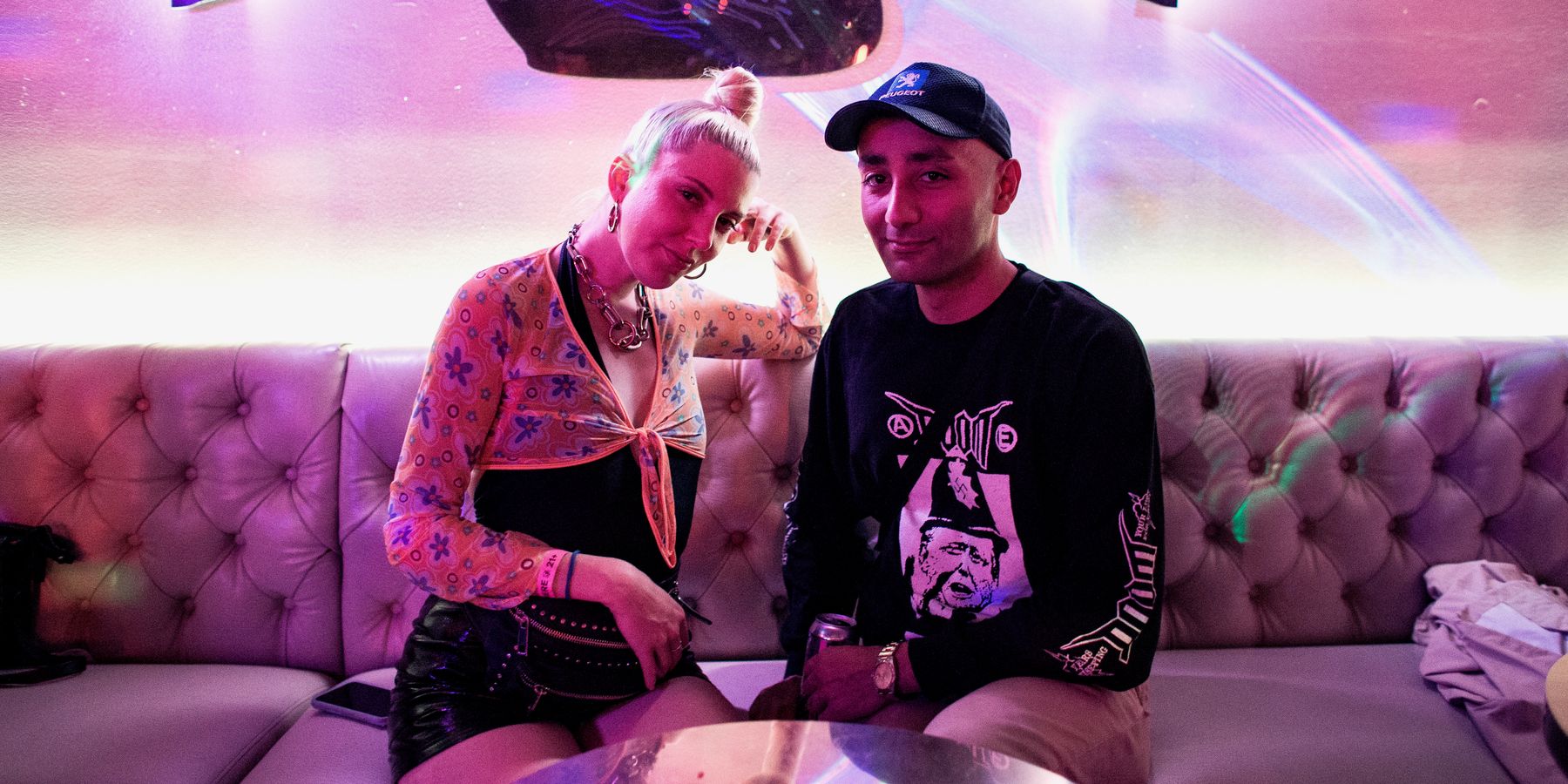
Brooklyn nightlife is in transition. It's been years since basements and warehouses gave way to a more regulated club-centric scene. But already, a wave of beloved bars and venues, particularly of the glittery, gritty hole-in-wall variety like Spectrum to Output, have been pushed out or are hanging by a GoFundMe: victims of gentrification's rising operation costs and hungry developers.
Enter Elsewhere, a cavernous indie club-meets-rock hall off the Jefferson L stop in Bushwick, which opened its doors in 2017, aiming to provide modern infrastructure to Brooklyn's scene while maintaining a DIY, for-the-people ethos. It's working: Elsewhere has become a home base for an incredibly diverse line-up from indie rock staples (Mitski, Porches), moshing punks (Iceage), pop faves (SOPHIE, Kim Petras, Rina Sawayama), up-and-coming rappers (Thutmose, Bali Baby) plus, of course, long lists of newcomers and DJs with vowel-less, unpronounceable names.
It's among the few places to dance late into the night in Brooklyn that feels relaxed and unpretentious — but also forgoes gritty nostalgia for "the idea of a DJ in a dark warehouse." Elsewhere might look like an industrial compound from outside, through in its doors is a menagerie of curated rooms: Zone One is a cozy disco-ball lit bar space, The Hall is a minimalist sculptural cavern, The Rooftop is a casual summer haven, and the newly renovated Loft is a swinging happy hour lounge.
Safwat Riad and Signe Pierce — veterans of the NYC club world — are two of the designers responsible for it. Safwat, an industrial designer (whose resume includes work on Bossa Nova Civic Club, Mood Ring, Juno, Short Stories, Output, Mirage and others) conceptualized the space, while Signe, a multimedia artist, set the mood with lighting. The pair first met while working together on Rose Gold, a nearby Bushwick club.
Together, for Elsewhere's (metaphorical) attic, they created a '70s-inspired lounge that joins the warm tones of a "back-to-nature" utopia with "high tech futurism." With stripy floors, draping plants, soft pink and blue lighting, exposed wood and spaceship-like portal windows, The Loft is a retro-futuristic garden party and an all-purposes watering hole. It's "the first to open and last to close" of Elsewhere's rooms: the perfect cozy happy hour spot, located on top of the coolest music venue. Opening at 5:00 PM each day, friends can grab a drink before heading downstairs for the show, or stay upstairs to dance while DJs spin from the sculptural, glowing orb-like DJ booth, custom designed by Safwat — who sees the DJ booth as "the modern day piano, a centerpiece."
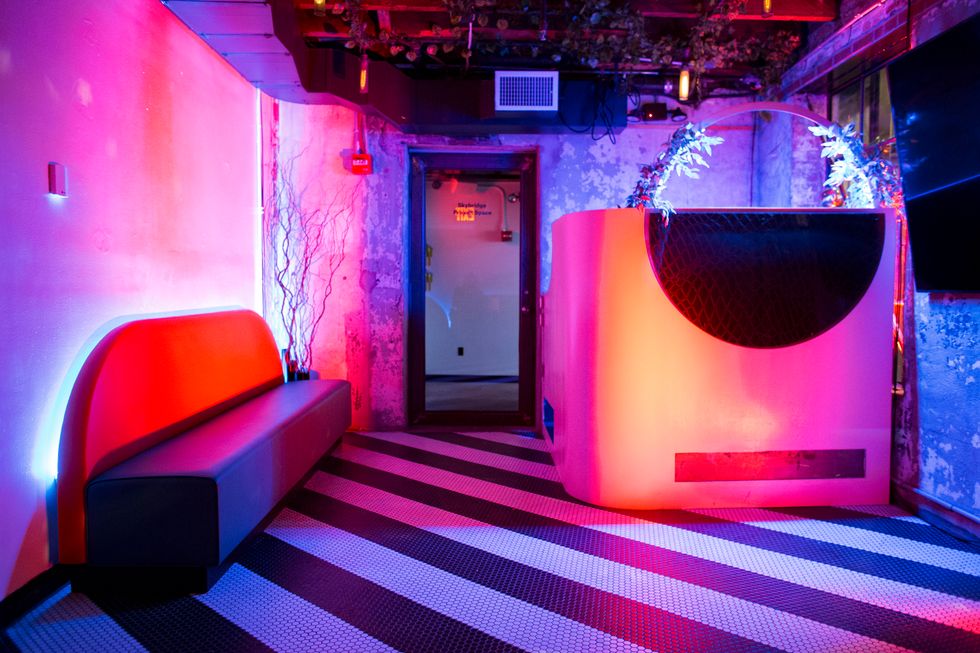
Photo: Luis Nieto Dickens / @nietodickens
PAPER sat down with Signe and Safwat to chat about The Loft, Elsewhere's niche in Brooklyn's landscape, and their perspectives on the state of NYC nightlife at large.
Tell me a little about your design concept for the Elsewhere Loft. What atmosphere you were trying to create?
Safwat: For the loft, I wanted to focus on exploring the music, art, and interior design of the 70's, a period dominated by sleek, minimalist modernism, earth tones, warm colors, nature-loving hippie domes, and high tech futurism. The era was greatly influenced by the back-to-nature movement that arose from the hippie rejection of consumerism and materialism, which resulted in an aesthetic focused on mesh surroundings and open-plan living with big windows, indoor gardens, hanging plants, and exposed ceiling beams.
My goal for the loft was to create a 70's time warp experience with a modern twist. I wanted it to be as if you were walking into a Stanley Kubrick film, the bath scene from The Shining or Korova Milk Bar in A Clockwork Orange. These concepts developed in the early stages came about after going to the Elsewhere's former venue, Glasslands, in early 2008-2012 to watch psychedelic, noise and experimental rock bands, seeing the famous LED lit-up clouds from the balcony, riding my bike with an exciting date and painting graffiti on my way there and back. There was something quite romantic and exciting about the experience.
Signe: It's really amazing how much light can impact the energy of a space, so for the Loft we wanted to focus on creating a more nurturing, intimate space from the other areas of Elsewhere. One of my favorite aspects of nightlife that I think is often overshadowed by the partying are the intimate conversations that you end up having with people once you're off the dance floor, sitting in the lounges, booths and more low key areas of the club. This is a zone where people can come to have a conversation.
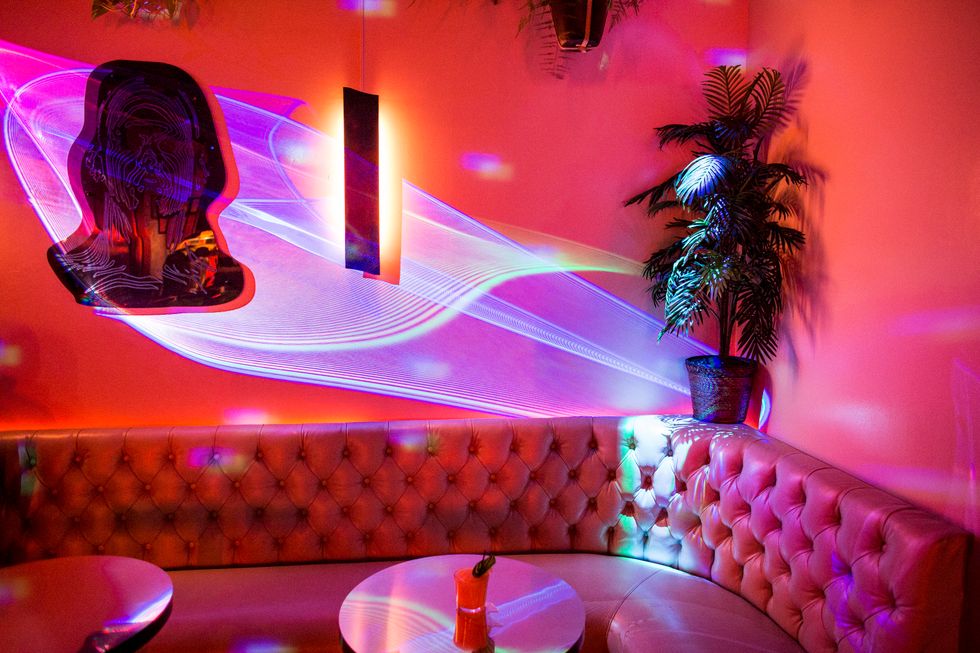
Photo: Luis Nieto Dickens / @nietodickens
Any inspirations/precedents you were drawing from aesthetically?
Safwat: My process starts by warming up my hands with line work and geometric shapes from mood boards I create that fit each project, later extruding a lot of the ideas into Rhino and Blueprints for the space. Then I transform it into CN4D renders that allow me to visualize the materials, looks, lighting, in 360 VR renders.
Signe: For me, the goal for this project was to create warmth and dynamism in the space using architectural accent lighting while working to highlight key elements of Safwat's designs. When I came into the original space before construction, I turned off all the lights and started adding lighting, one by one, to see which areas really needed to glow up. After that I mixed the results with Safwat's renders in order to figure out how and where the lighting could best be utilized, which ended up leading to the creation of a few unique lighting fixtures that his studio constructed and designed for the space.
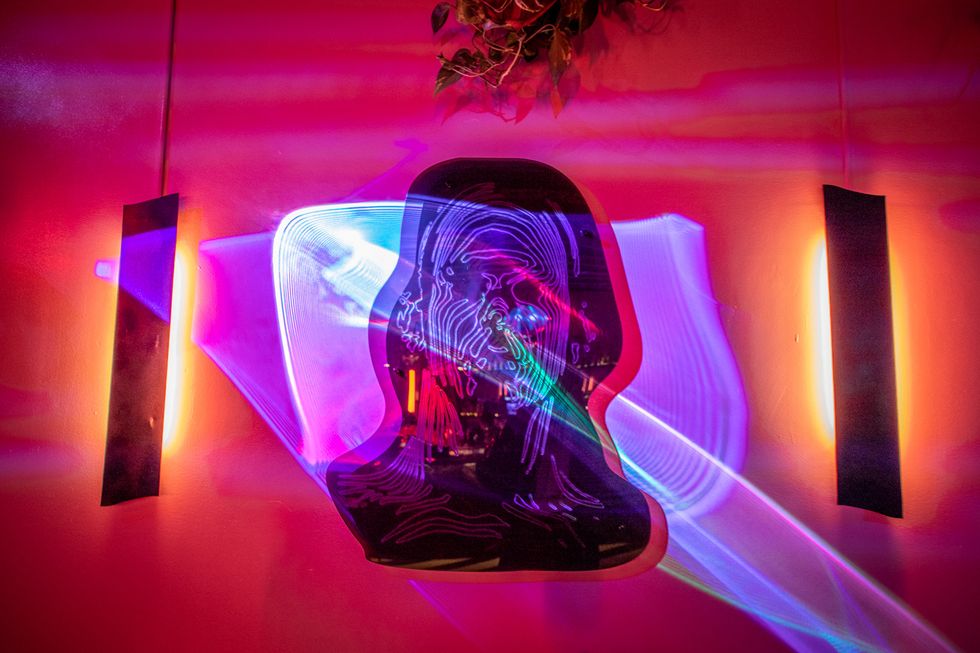
Photo: Signe Pierce
When and why did you get involved in designing club spaces?
Safwat: I was born and raised in Alexandria, Egypt in a family full of architects and engineers. Growing up, I also watched my father hosting large-scale parties in our backyard for work events, so I grew up seeing how much effort goes into production for a few hours of entertainment. I saw Jean Michel Jarre's "The Pyramid's Millenium Sound and Light Performance" at the Pyramids in Giza, which was an incredible performance at a magical historical place.
A few years later I was doing live visuals and DJing when I met Bossa Nova Civic Club owner John Barclay, who gave me one of my first commissions designing the facade of their DJ booth. This led me to Magick City in Greenpoint, Output, Mood Ring, Rose Gold, Sustain Release and eventually Elsewhere.
Signe: I had done a lot of lighting and projection installations with brands and galleries, but my first real foray into club lighting was working as the creative director of Rose Gold Cocktail Bar in Bushwick in 2017. I had been working on music videos and photo shoots before I started getting into interiors. It seemed like a natural progression, given that a big part of my artistic output has me using color and lighting as a primary medium. I think that lighting is a really underrated art form in nightlife and in interior design — it just seems to be an afterthought for a lot of people, when in actuality it is one of the most essential design elements to be considered. I enjoy the act of curating vibes and auras for people to connect in, which is what nightlife and club scenes are all about.
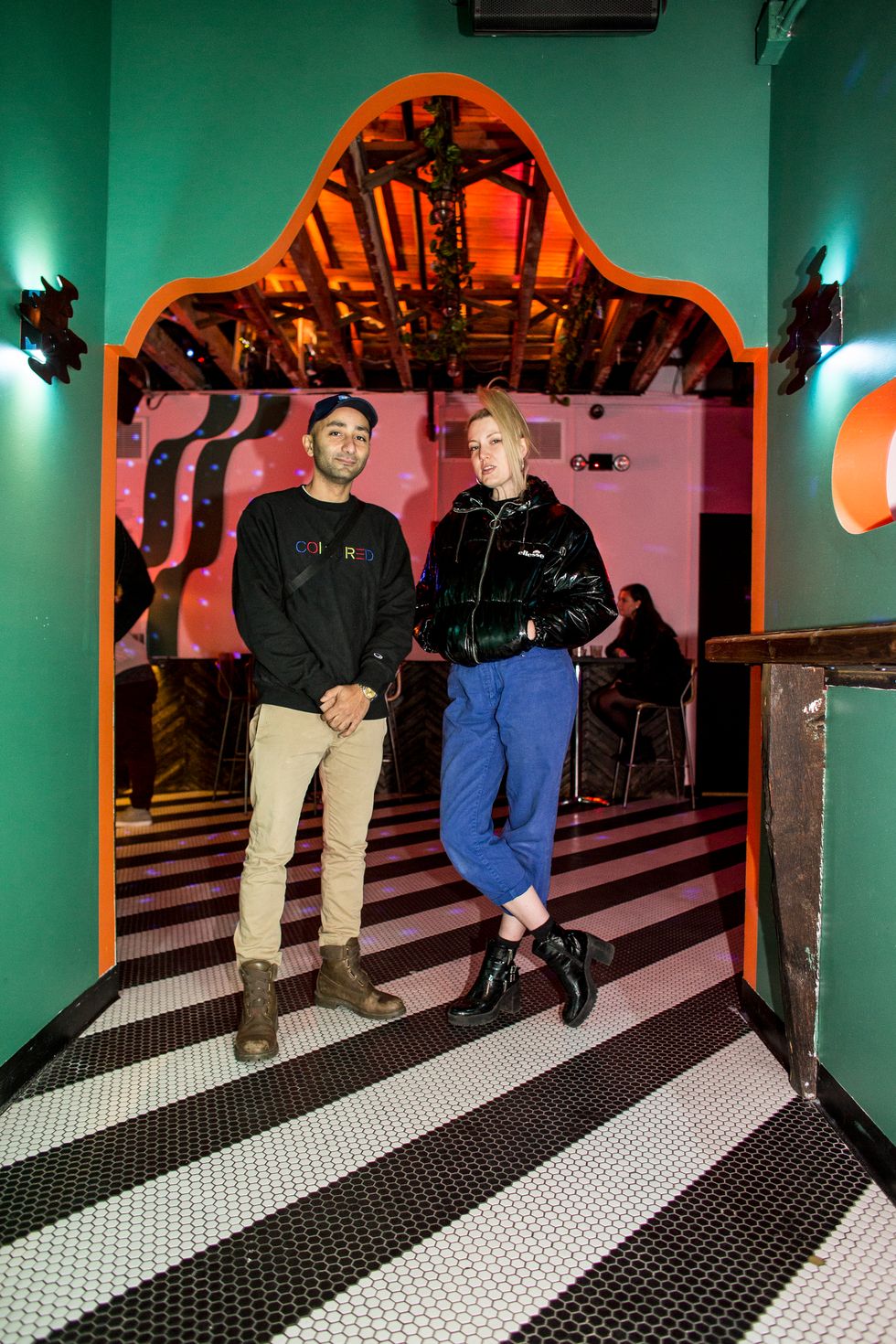
Photo: Luis Nieto Dickens / @nietodickens
What has it been like seeing people respond to and interact with the space?
Signe: It's been really positive! Nothing makes me happier than casually viewing people's Instagram stories and seeing that they're hanging out in the space.
Safwat: There has been a lot of good reviews, a lot of events, a lot of making out, a lot of selfies and a lot of dancing. People seem to enjoy the fresh new look of the space: the transition from dark entrance to a bright space, the sleek opening in the wall, the open space, the more intimate seating arrangement, My team did an incredible job: from Signe's colorful lighting, Kristine's vibrant plants – it all came together really well. The overall vibe is chic, minimal, stylish, warm, comfortable, and fun. I have definitely witnessed many great moments in the space.
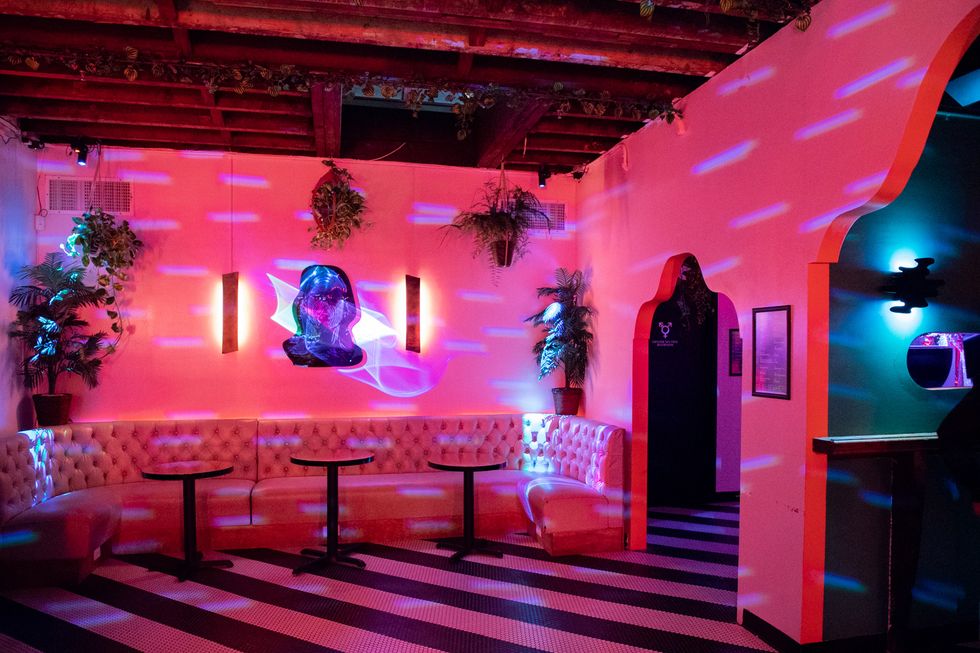
Photo: Signe Pierce
What do you see as Elsewhere's niche in NYC nightlife?
Safwat: At the moment, I think Elsewhere stands at the top with its unique characteristics. They have tons of space. It's affordable and in a great location. Most importantly, they cater to all sorts of crowds with interests ranging from experimental rock to techno. Especially with Output and Spectrum unfortunately closing down, people need a safe space to get their freak on. It also provides a space to foster new talent and showcase up-and-coming artists, allowing for all sorts of immersive art experiences including DJs, bands, performers, and dancers. Elsewhere is a large-size venue that is able to handle large events with professional production that still remains connected to the underground.
Signe: I feel like Elsewhere is a stylish, mature venue space for Bushwick that feels both contemporary and authentic. For fans of alternative/indie/underground music, the East Village and Williamsburg venues have dominated the scene, but now we're giving Bushwick its time.
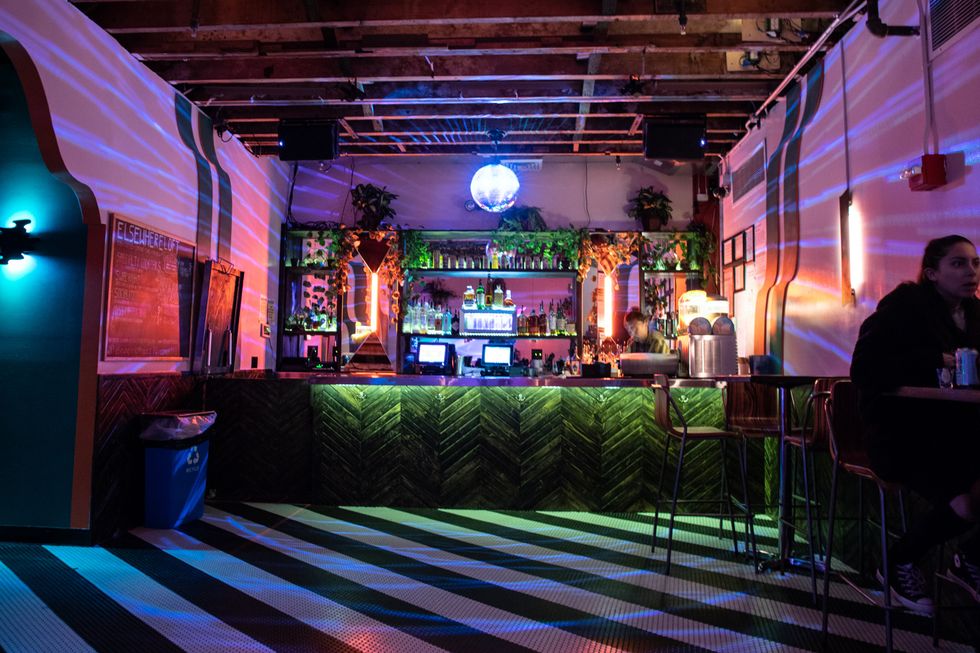
Photo: Signe Pierce
What has it been like to get to curate so much of the NYC and Brooklyn club scene?
Safwat: I see designing club spaces as designing the modern-day church. Which parallels to the Sistine chapel ceiling painted by Michelangelo. The club is a space where everyone comes together from all different walks of life to experience pure joy & inspiration. I want people to feel as if everyone in the space is abstractly involved in a performance art piece. I also see the DJ booth as a modern day piano, a centerpiece where people gather to dance and watch musical performance. For me personally this more than just a job. It's more of a purpose to create beautiful experiences for people.
It has always been a dream of mine to be a contemporary techno architect. It's a really exciting time for music and technology. Using VR to purpose my vision to clients. Using technology like CNC MACHINES, PLASMA, LASER to cut custom shapes and engrave in materials. Programmable lighting, it's also becoming a lot more accessible and easy to use every day. Its more exciting with the third industrial revolution on rise. 3D printing and Robotic 5 axis CNC machines are also on rise. Now days you can spray coat sculptures and materials with metals like steel and copper which was under heard of before.
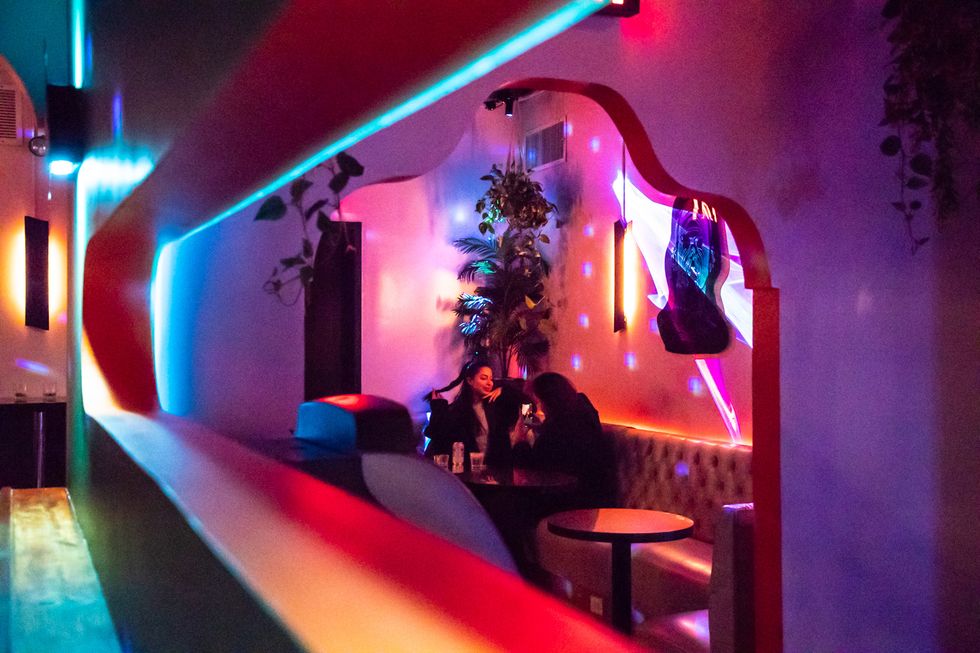
Photo: Signe Pierce
What do you make of the state of NYC and Brooklyn nightlife? How have you seen it evolve as you've been working as a designer in the scene?
Safwat: It's evolved tremendously, largely in part to the Let NYC Dance movement and repeal of the Cabaret Law, but as well to the crack down occurring on these DIY venues and raves. It's fascinating to see clubs open and close, and saddening to see community staples like Spectrum and Output forced to close their doors.
This era reminds me of the Italian radical disco-embodying the architecture and night life of the 60s. Night clubs were opening across Italy, collaborating with visual, light, installation and performance artists to create these environments outside of what had become the "norm" for clubs. The best example of this would have to be Piper Club, which opened in 1965 in an abandoned cinema in Rome. Young and experimental designers and architects (Gianni Colombo, Gruppo 9999 and Super Studio, to name a few) were brought on to build out a space that explored reconfigurable furnishings, while utilizing advanced audio and visual technologies, to create a unique experience relatively foreign to the nightclub circuit at the time. You see this happening a lot in these New York venues and it's definitely evolving into something a lot greater than just the idea of a DJ in a dark warehouse.
Signe: I've been living in New York for 11 years — so while I'm not a certified OG, I've seen a lot of spaces come and go. Over the years, NYC nightlife has had its ups and downs, but I would say that we are definitely in an upswing right now. I remember around 2011, I felt really disenchanted with the New York Scene — everything felt commodified and soulless. All the Brooklyn bars looked like they were designed by artisanal taxidermists, and in order to have a real club experience you had to lug yourself to the West Side Highway to go to one of the bottles-and-models clubs that are built around exclusivity and privileged hierarchies. A lot of people can't afford that kind of bougie club experience, and honestly don't want to be around that kind of bloated excess, so it was amazing to watch Brooklyn, and specifically Bushwick, start to take the reigns around 2012 by fostering multiple legendary party spaces and underground raves.
We've lost a lot of the great Brooklyn DIY spaces in the past 5 years — Body Actualized Center, Glasslands, Steel Drums, 285 Kent and Trip House come to mind — but there's also been a shift in the nightlife scene with some of these DIY space runners opening real, legitimate establishments. Bossa Nova Civic Club spawned from 285 Kent, SPR from Happy Fun Hideaway, Elsewhere spawned from Glasslands, and these spaces are continuing to spawn other new, great spaces like Mood Ring and H0L0. There are a lot of incredible underground parties that happen every month, if you know where to find them. The range and variety of programming in all of these spaces reflect a culture built around inclusivity and progressive energy which (in my opinion) makes Bushwick the most exciting scene in the city.
Lead photo: Luis Nieto Dickens / @nietodickens